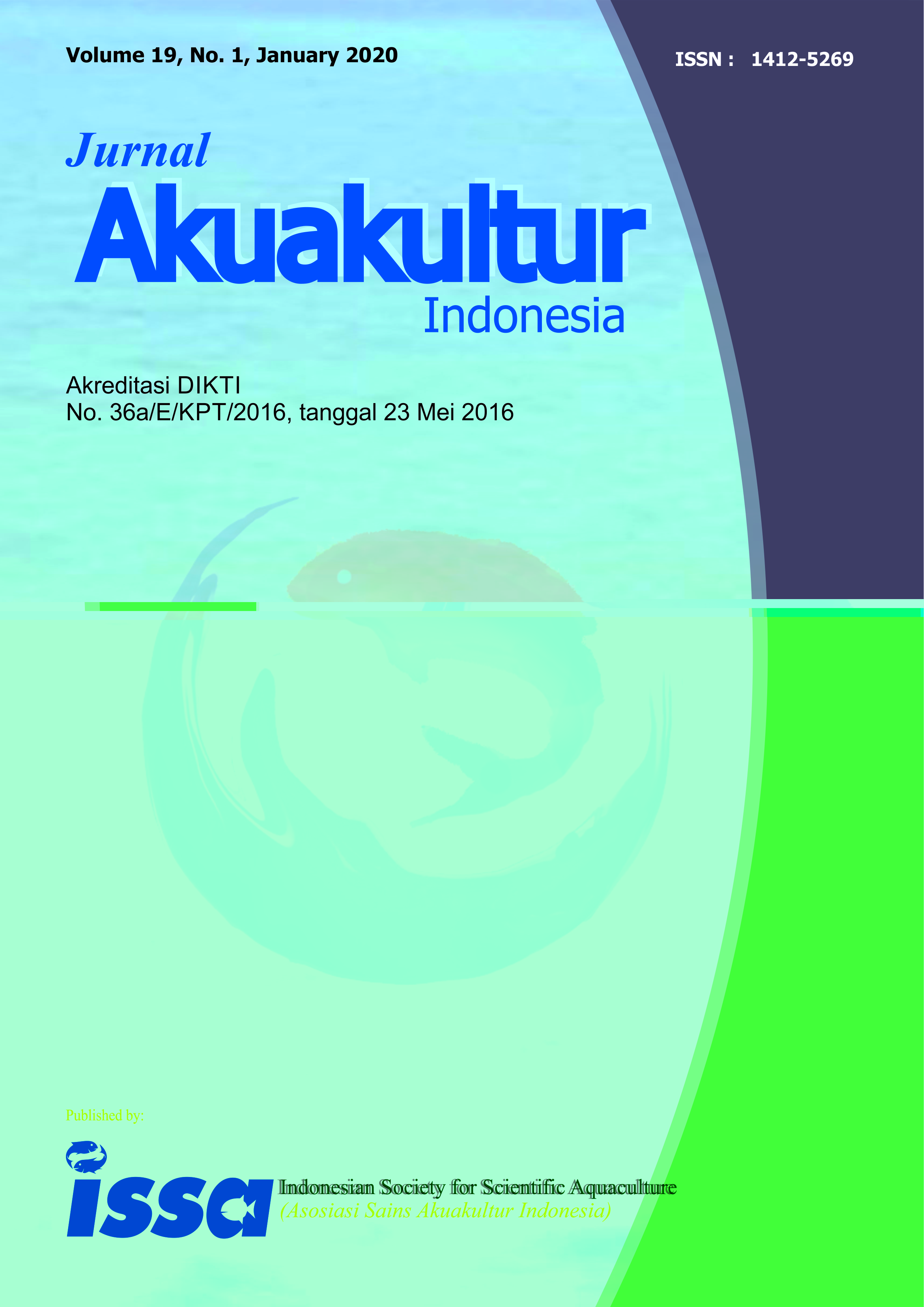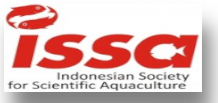Reproductive performance of catfish Clarias sp. with probiotics Bacillus sp. NP5 addition through feed
Abstract
ABSTRACT
The intensification of catfish culture requires a regular and sustainable good seeds quality. Microbial-based aquaculture with probiotic application is expected to improve the reproductive performance of catfish. The aim of this study was to evaluate the reproductive performance of catfish given probiotics Bacillus sp. NP5 with different concentrations through feed. This study used a Completely Randomized Block Design (CRBD) with the administration of probiotic Bacillus sp. NP5 at 2% concentration of 108 CFU/mL and 1010 CFU/mL in feed given and control (without probiotics), then repeated four times. Catfish broodstocks with an average size of 955 ± 261.27 g were kept in a net sized 1 m×1 m×1 m with seven broodstocks per net. Parameters observed included the Gonadosomatic Index (GSI), fecundity, number of matured eggs, frequency distribution of egg diameter, fertilization rate, and hatching rate. The result showed that the GSI value of female catfish broodstock was significantly different in sixth week as the highest value was obtained from 1010 CFU/mL probiotics with 5.19%. Moreover, the fecundity of all treatments showed significantly different results (P<0.05) as the highest value was on the concentration of 1010 CFU/mL Bacillus sp. NP5 with 137,123 ± 32,635 eggs/broodstock. This study concludes that the administration of probiotics Bacillus sp. NP5 with 1010 CFU/mL in feed given to catfish broodstock increases the fecundity (137,123 eggs/broodstock), GSI (5.19%), number of matured eggs percentage (64.50%), and hatching rate (82.53%).
Keywords: Bacillus sp. NP5, catfish, reproductive performance
ABSTRAK
Intensifikasi budidaya ikan lele menuntut penyediaan benih yang berkualitas secara teratur dan berkelanjutan. Budidaya berbasis mikroba diharapkan dapat meningkatkan kinerja reproduksi ikan lele. Tujuan penelitian ini adalah mengevaluasi performa reproduksi ikan lele yang diberi probiotik Bacillus sp. NP5 dengan konsentrasi berbeda melalui pakan. Penelitian ini menggunakan rancangan acak kelompok lengkap (RAKL) dengan pemberian probiotik Bacillus sp. NP5 pada konsentrasi 108 CFU/mL dan 1010 CFU/mL sebanyak 2% dari pakan yang diberikan serta kontrol (tanpa pemberian probiotik), masing-masing dengan empat ulangan. Induk ikan lele dengan ukuran 955 ± 261.27 g dipelihara pada jaring hapa ukuran 1 m × 1 m × 1 m sebanyak tujuh ekor per jaring hapa. Parameter yang diamati meliputi indeks kematangan gonad (IKG), fekunditas, jumlah telur matang, sebaran frekuensi diameter telur, derajat pembuahan, dan derajat penetasan. Hasil penelitian menunjukkan bahwa nilai IKG induk betina ikan lele berbeda nyata pada minggu keenam dengan nilai tertinggi diperoleh pada perlakuan probiotik 1010 CFU/mL yaitu sebesar 5.19%. Selain itu, fekunditas semua perlakuan menunjukkan hasil yang berbeda nyata (P<0.05) dengan nilai tertinggi pada perlakuan pemberian probiotik Bacillus sp. NP5 dengan konsentrasi 1010 CFU/mL sebesar 137,123 ± 32,635 telur/induk. Kesimpulan, pemberian probiotik Bacillus sp. NP5 dengan konsentrasi 1010 CFU/mL melalui pakan kepada induk ikan lele mampu meningkatkan nilai fekunditas 137,123 telur/induk, GSI 5,19%, persentase jumlah telur matang 64,50% dan derajat penetasan telur 82,53%.
Kata kunci: Bacillus sp., ikan lele, performa reproduksi
Downloads
Authors who publish with this journal agree to the following terms:
- Authors retain copyright and grant the journal right of first publication with the work simultaneously licensed under a Creative Commons Attribution License that allows others to share the work with an acknowledgement of the work's authorship and initial publication in this journal.
- Authors are able to enter into separate, additional contractual arrangements for the non-exclusive distribution of the journal's published version of the work (e.g., post it to an institutional repository or publish it in a book), with an acknowledgement of its initial publication in this journal.
- Authors are permitted and encouraged to post their work online
 (e.g., in institutional repositories or on their website) prior to and during the submission process, as it can lead to productive exchanges, as well as earlier and greater citation of published work (See The Effect of Open Access).
(e.g., in institutional repositories or on their website) prior to and during the submission process, as it can lead to productive exchanges, as well as earlier and greater citation of published work (See The Effect of Open Access).






















